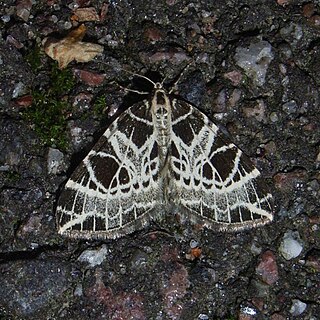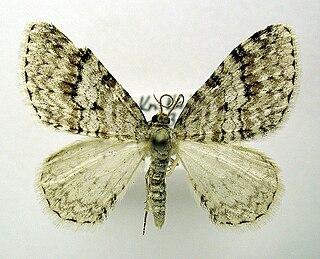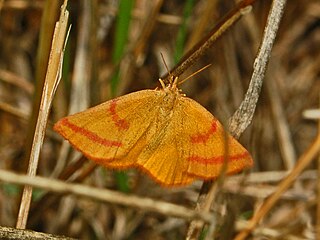
Pyrausta is a speciose genus of moths of the family Crambidae. The genus was erected by Franz von Paula Schrank in 1802.
Eurytaphria is a genus of moths in the family Geometridae first described by Warren in 1893.

Eustroma is a genus of moths in the family Geometridae erected by Jacob Hübner in 1825.
Pomasia is a genus of moths in the family Geometridae.

Venusia is a genus of moths in the family Geometridae erected by John Curtis in 1839.

Lythria purpuraria, the purple-barred yellow, is a species of moth of the family Geometridae. It is found from western Europe to Siberia, Russia, Ukraine, Turkmenistan and Kazakhstan.

Venusia cambrica, the Welsh wave, is a moth of the family Geometridae. It is found in Europe, western and central Siberia, Altai, Transbaikalia, the Russian Far East, the Korean Peninsula, Japan and in North America, where it can be found across Canada from Newfoundland and Labrador to British Columbia, south in the west to California, south in the east to Georgia.

Eupitheciini is a tribe of geometer moths under subfamily Larentiinae, often referred to as pugs. The tribe was described by Tutt in 1896.

Sterrhini is a tribe of the geometer moth family (Geometridae), with about 825 species in 19 genera. There are also 6 genera with 36 species tentatively associated with the tribe. The tribe was erected by Edward Meyrick in 1892.

Nomenia duodecimlineata is a moth in the family Geometridae first described by Alpheus Spring Packard in 1873. It is found in western North America, from British Columbia to California, Nevada, Arizona and New Mexico.

Venusia comptaria, the brown-shaded carpet moth, is a moth in the family Geometridae. The species was first described by Francis Walker in 1860. It is found in eastern North America, from Florida to Newfoundland, west to Manitoba. The habitat consists of woodlands.
Venusia conisaria is a moth in the family Geometridae first described by George Hampson in 1903. It is found in China, Nepal and India.
Venusia laria is a moth in the family Geometridae first described by Charles Oberthür in 1893. It is found in China and Japan.
Venusia lilacina is a moth in the family Geometridae first described by William Warren in 1893. It is found in China, Nepal and India.
Venusia megaspilata is a moth in the family Geometridae first described by William Warren in 1895. It is found in Japan and Korea.
Venusia ochrota is a moth in the family Geometridae first described by George Hampson in 1903. It is found in Nepal and China.
Venusia pallidaria is a moth in the family Geometridae first described by George Hampson in 1903. It is found in Pakistan.
Venusia semistrigata is a moth in the family Geometridae first described by Hugo Theodor Christoph in 1881. It is found in Russia and Japan.
Stenoporpia purpuraria is a species of moth in the family Geometridae first described by William Barnes and James Halliday McDunnough in 1913. It is found in North America.







